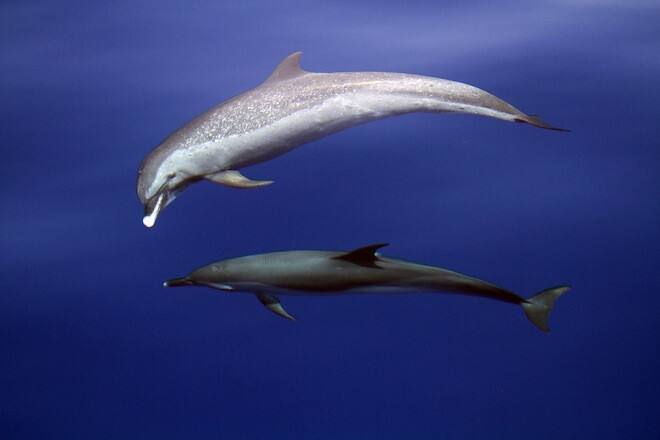Stenella attenuata
IUCN
LCBasic Information
Scientific classification
- name:Stenella attenuata
- Scientific Name:Stenella attenuata,Pantropical spotted dolphin,Tropical spotted dolphin, weak dolphin, white-beaked dolphin
- Outline:Cetacea
- Family:Odontoceti Delphinidae Prodolphinidae
Vital signs
- length:166-257cm
- Weight:100-120kg
- lifetime:About 40 years
Feature
Spots on the skin that darken with age
Distribution and Habitat
The spotted dolphin is widely distributed, mainly in tropical waters, but also in subtropical and some temperate waters. In my country, it is only found in the waters near Suao, Taiwan. Although there seem to be a large number of them in many areas, their distribution within their habitat may not be continuous. They are widely distributed in the Atlantic, Indian, and Pacific Oceans, and migrate seasonally to the coast of Japan. They are also the most common whale species in the Gulf of Mexico.
Main distribution countries and regions (sea areas): American Samoa, Argentina, Australia, Bahamas, Bangladesh, Belize, Brazil, Cambodia, Cape Verde, Cayman Islands, China, Colombia, Comoros, Cook Islands, Costa Rica, Cote d'Ivoire, Cuba, Djibouti, Dominican Republic, Ecuador, Egypt, El Salvador, Equatorial Guinea, Fiji, French Polynesia, Gabon, Ghana, Grenada, Guadeloupe, Guam, Guatemala, Guinea, Haiti, Honduras, Hong Kong, India, Indonesia, Jamaica, Japan, Kenya, Kiribati, Madagascar, M
Appearance
As the spotted dolphin ages, the color of its skin spots gradually deepens, so it is called "spotted" dolphin. The back of the adult is dark gray with varying numbers of white spots. The ventral side is grayish white with dark spots. Newborn dolphins have no spots, and then some dark spots will grow on the abdomen first, and then light spots will grow on the back of the body; the number and size of the spots will increase with age. Some older dolphins have so many spots that the background color is almost completely unrecognizable, and the back of the body appears very light in color.
The bright white beak is another characteristic, with most adults having a white tip. The fat area is located on the forehead, forming the forehead. There is a significant fold between the forehead and the long beak. The dorsal fin is narrow and sickle-shaped, and there are 29 and 37 small round teeth on each side of the upper and lower jaws. The spiracles on the top of the head are used for
Details
Pantropical spotted dolphin, with two subspecies, may be the most common cetacean.

Pantropical spotted dolphin is a social animal, swimming in groups of a few to thousands, with more members in offshore groups than in coastal groups. In Japanese waters, 2-year-old dolphins will join other dolphins until they grow up and return to their original group. Female dolphins leave the group during estrus. Perhaps because of overlapping feeding areas, they often swim with schools of yellowfin tuna in the eastern Pacific, and of course it may also be a protective measure against natural enemies.
Spotted dolphins swim fast, reaching 22-28 km/h, and the fastest speed can reach 40 km/h. (Recorded during US Navy experiments). They are accustomed to jumping out of the water in a juggling manner, and when there are passing ships, they will ride the waves of the ships to perform a series of aerial acrobatics, except in tuna fishing grounds, where they have learned to avoid fishing boats.
Spotted dolphins find food by echolocation. At night, they prey on small fish, squid and crustaceans on the sea surface, and also eat isopods and pteropods. In many areas, spotted dolphins mainly feed on aquarium/flying-fish.html">flying fish. Their natural enemies are killer whales and various sharks.
The average age of sexual maturity for female dolphins along the northern coast is 11.1 years, which is longer than the 9.8 years of female dolphins in the southern offshore. Males reach sexual maturity at an average age of 14.7 years. Although the reproduction rate increases in spring and autumn, there is no fixed breeding season. In the eastern Pacific, the interval between births is 26-36 months, and in the Japanese waters it is 48 months. The gestation period lasts less than a year, and the lactation period is more than 1.5 years, which is more than three times that of other whales. One calf is born per litter, and multiple calfs are extremely rare.
An estimated 228,038 spotted dolphins live in the eastern Pacific coastal waters (CV=34%), with 737,000 in the northeastern waters (2003), a 76% decrease from 1959, and despite a sharp decline in mortality in recent years, the population has shown no clear signs of recovery. The 2000 estimate for the same area was 876,075 (CV=31%). There were 8,978 in Hawaiian waters (CV=48%, 2006). About 438,000 live in the waters off Japan (1993). The total number is estimated at 34,067 (CV=18%) in the northern Gulf of Mexico and 14,930 (CV=41%) on the east coast of the United States. The population is estimated at 14,930 (CV=41%) in the eastern Sulu Sea and 640 (CV=27%) in the Tañon Strait between Negros and Cebu. Population trends are unknown. However, since the 1960s, the population in the tropical waters of the eastern Pacific has dropped by 65% due to the impact of fishing nets.
Listed in Appendix II of the Convention on International Trade in Endangered Species of Wild Fauna and Flora (CITES).
Listed in the IUCN Red List of Threatened Species: Least Concern (LC), assessed in 2012.
Listed in the second level of the "List of National Key Protected Wildlife in China".
Protect wild animals and eliminate game.
Maintaining ecological balance is everyone's responsibility!








